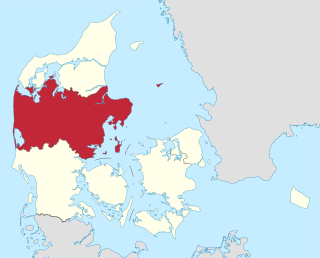Related Research Articles

The Central Denmark Region, or more directly translated as the Central Jutland Region and sometimes simply Mid Jutland, is an administrative region of Denmark established on 1 January 2007 as part of the 2007 Danish municipal reform. The reform abolished the traditional counties (amter) and replaced them with five new administrative regions. At the same time, smaller municipalities were merged into larger units, cutting the total number of municipalities from 271 to 98. The reform diminished the power of the regional level dramatically in favour of the local level and the national government in Copenhagen. The Central Denmark Region comprises 19 municipalities.

The 2010 Danmark Rundt was a men's road bicycle race held from 4 to 8 August 2010. Danish rider Jakob Fuglsang of Team Saxo Bank captured the overall title. This was the third Danmark Rundt victory for Fuglsang, the most in the race's history. It was the 20th edition of the men's stage race, which was established in 1985.
The 2015–16 Danish Cup was the 62nd season of the Danish Cup competition. The winners of the competition qualified for the second qualifying round of the 2016–17 UEFA Europa League.

The 2017–18 Danish 1st Division season was the 22nd season of the Danish 1st Division league championship, governed by the Danish Football Association.
The 2018–19 Danish Cup, also known as Sydbank Pokalen, was the 65th season of the Danish Cup competition. The winners of the tournament, Midtjylland, earned qualification into the third qualifying round of the 2019–20 UEFA Europa League.

The 2018–19 Danish 1st Division season is the 23rd season of the Danish 1st Division league championship, governed by the Danish Football Association.

The Danish Constituent Assembly is the name given to the 1848 Constitutional assembly at Christiansborg Palace in Copenhagen that approved the Danish Constitution and formalized the transition from absolute monarchy to constitutional democracy. It consisted of members of which 114 were elected by the people, 38 were appointed by the king and the rest were government ministers.

The 2019–20 Danish 1st Division season was the 24th season of the Danish 1st Division league championship, governed by the Danish Football Association.
The 2020–21 Danish Cup, also known as Sydbank Pokalen, was the 67th season of the Danish Cup competition.
The 1926 JBUs Pokalturnering was the 3rd edition of the regional tournament, JBUs Pokalturnering, the highest senior cup competition organised by the Jutland FA (JBU). The tournament was held in the third and fourth quarter of 1926 with Aalborg BK as the defending cup champions. The season was launched on 22 August 1926 with the first round, embraced five cup rounds and concluded on 21 November 1926 with the cup final. A total of 29 clubs participated in the cup tournament, which was the same number of teams as the previous season.
Constituencies are used for elections to the Folketing, the national parliament of Denmark. Denmark proper is divided into 10 constituencies largely corresponding to the Provinces of Denmark, each electing multiple members using open-list proportional representation. Those constituencies are then divided into 92 opstillingskredse which mainly serve the purpose of nominating candidates, but historically functioned as single-member constituencies electing one member using plurality voting.
The 1963–64 Danish Cup qualifying rounds inaugurated the 10th season for the Danish Cup. The qualifying rounds of the cup tournament were governed by the six regional football associations, the Bornholm FA, Copenhagen FA, Funen FA, Jutland FA, Lolland-Falster FA and Zealand FA. 671 teams were registered for the qualifying rounds, of which only 44 teams would quality for the proper rounds, under the auspices of the Danish FA's tournament committee, joined by 36 additional teams from the first, second and third divisions in the Danish football league system. The Danish FA dictated that the ticket prices to the qualifying matches should be at least DKK 2 for adults and DKK 1 for children.
The 1964 Jutland Series was the 66th edition of the Danish fifth-tier association football division since its establishment in 1902. Governed by the Jutland Football Association (JBU), the season was launched on 30 March 1964, and the last round of regular league matches concluded on 8 November 1964, with the league championship final being played on 15 November 1964. Silkeborg IF, Vorup Frederiksberg BK, Brande IF and Holstebro BK entered as relegated teams from last season's fourth-tier, while Hobro IK, Vejen SF, Viborg FF (reserves) and Aabyhøj IF Thrott entered as promoted teams from the 1963 JBUs Serie 1. Fixtures for the 1964 season were announced on 13 March 1964, 2½ weeks prior the season's start. The league featured reserve teams for higher ranking league clubs, whose players could indiscriminately be used on both the league and reserve teams, after a quarantine period of one match day.